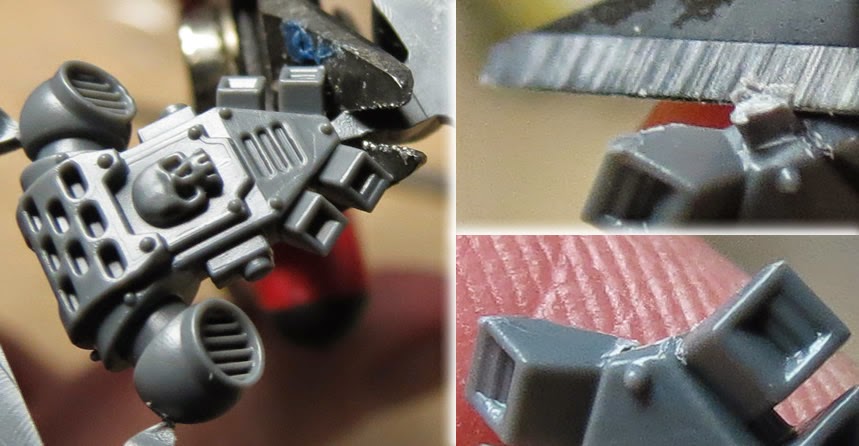I've talked about cleaning mould lines before, but this'll use more practical examples.
Using Knives
I approach cleaning mould lines with knives in one of two ways: Scraping or Slicing. Scraping uses the blade as just an edge which levels out the surface. Slicing actually cuts the surface, removing whatever you want.
.jpg)
Scraping
This is the process of angling the blade AWAY from the direct you move the knife. That way the sharp edge rubs against the surface without cutting it.
Most of the time, this is the best way to do it because there's less chance of damaging your parts. Just scrape all the lines off.
Slicing
When slicing, you angle the blade TOWARD the direction you're moving the blade, thus actively cutting stuff from your part.
This is best used when there are larger bits you'd like to remove. Things like leftover sprue, like that on the elbow in the slicing photo or to make two piece fit together smoothly like the wrist and hand holding the gun.
Just have to be extra careful using this method, especially if the parts are plastic. (Softer material than metal.) If you use too much force or slip, you could end up cutting important parts off.
And always cut away from you to avoid chances of injury.
When I was removing bits from sprues, some tabs get left behind because the snips just wouldn't fit. This is also a good time to slice. (But notice how in the final photo, there's a small slice where I cut too far.)
Make parts fit
Once again, slice off all the little places left from spruces, especially when you're gluing two parts together. A head piece won't fit as nicely or give you as wide a range of movement and an arm won't cleanly fit against a body.
Sometimes there are difficult, weird or curved areas that even give a knife some trouble. In these cases, you'll also probably use the slicing / cutting method. Get your knife on one side, then turn it, keeping the blade against your mini. That should scoop the garbage out.
Using Files (The Kid-Friendly Method)
Knives are the best way remove mold lines and sprue garbage, but they're not the safest around kids. Luckily, files work too. Just rub the rough area of the file against the surface of the miniature.
Some larger files also have filing surfaces on their thin sides, which gives you versatility in where they reach. You can also lay a file on your desk for extra leverage and rub the part against the file.
One down-side of files is that it leaves the surface rougher, as you can see.
Files come in different qualities and smoothnesses, just like sandpaper. Most files are on the "coarser" side, meaning they're rougher. Smaller hobby files are available which are finer or smoother. These are often covered in diamond dust (But not expensive.) instead of just large patterns cut in to metal.
For hard to reach areas, you can buy files in different shapes: Round, half-moon, triangular, etc.
.jpg)





